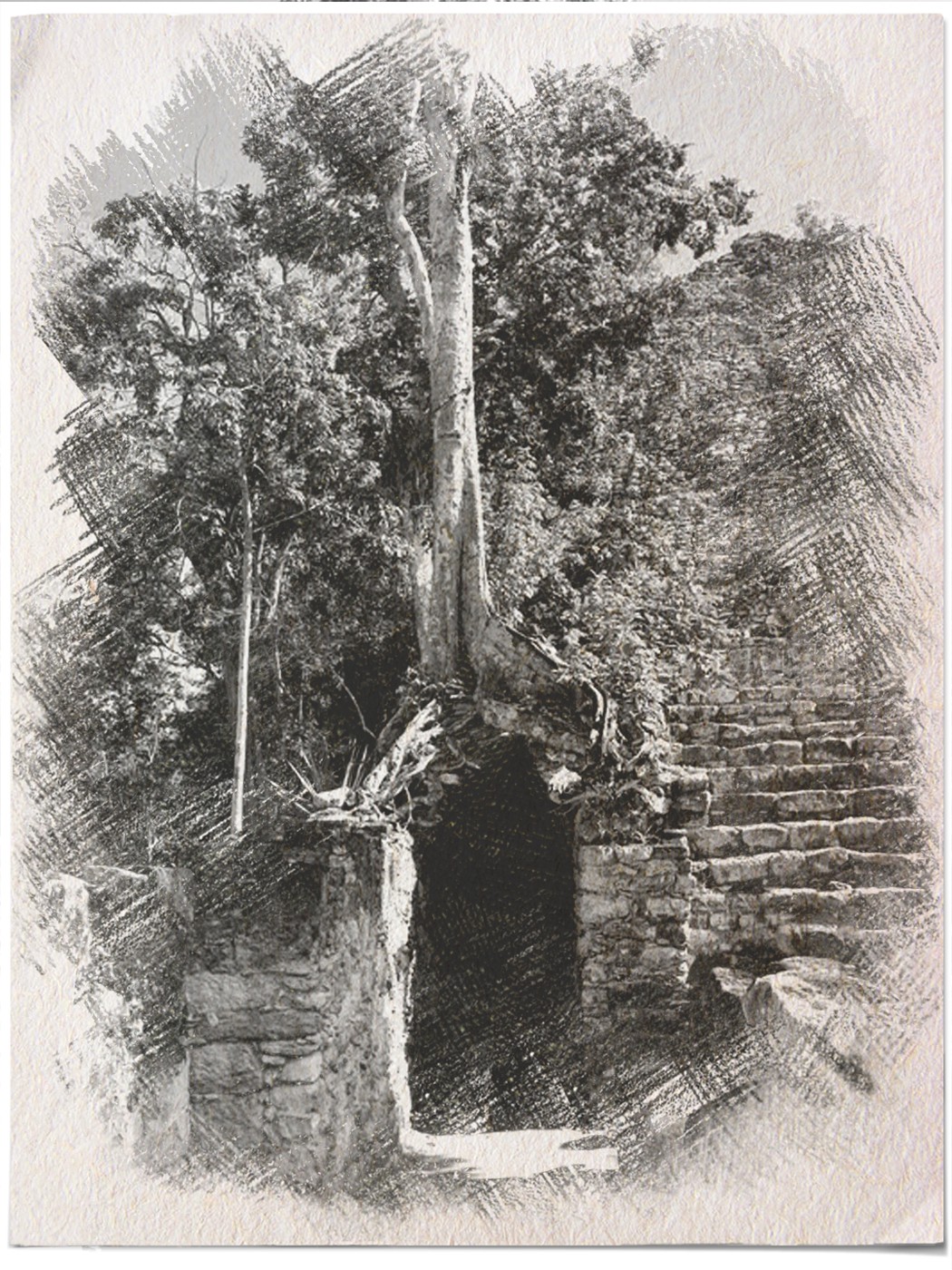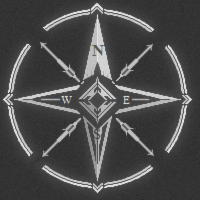Many ruins don't like visitors. Traps, undead, and more.
Then there are those ruins that would like you to stay... whether you like it or not…— Windtracer Tela Kioni
West of the
Temple of Draoses lies the remains of a settlement called the Obvion Complex. This structure is older than the Draoses temple by at least five decades, perhaps more. An
Ancient Order structure, it has withstood the test of time and the elements.
Today, the massive complex is only partially accessible because of the Anestri’for jungle’s persistent growth over the region. This has left the Obvion Complex a shadow of its former self. The same can be said for its mysterious and deadly inhabitants.
A Cathedral in Reverse
The building, or complex, is set among a series of hills that overlook Kanathi Bay in northern Chivit. This region is a small section of where the Chivit continent meets the southwestern point of the Great Chasm.
If you’re not looking carefully, it just looks like part of a crater. Then, you start to notice the doors… — Windtracer Tela Kioni
This building, based on what has both survived and explored, is all that remains of a much grander design. The stone supports for metal rib beams still remain firmly anchored in place around the crater today. Measurement of stones show the Obvion Complex itself once towered many stories over the landscape. The current estimates suggest Obvion was at least ten or more stories tall and possibly shaped like a dome.
Today, all above ground structures have long since been removed by the Great Collapse and time. Now, all that remains are tiered levels that descend the crater in concentric rings. The pattern is identical to terraced farming, or an elongarted inverted ziggurat. This architecture bears resemblance to the vaulted cathedral designs in other parts of Awldor, only the vault is built into the ground, instead of as a ceiling overhead.
Doors dot the crater walls between the monkey vines and briza-taeda ferns that grow aggressively over the ruin. Ruberi rubber trees grow thick along the top edge, their roots trailing down, sealing off most entrances. Because of the encroaching Anestri’for foliage, much of the Obvion is inaccessible. In fact, only a third of the complex can be seen or even reached.
An initial study of the location suggests that the terraced ‘crater’ design had two purposes. Entrance to underground living, and in fact the majority of the settlement, and to allow for local terraced community farms. Each plot of farmland was evenly interspersed between double door entrances into the underground portion of Obvion.

Door entrance to the ruin by Dreamstime Stock Free Photo
The farms aren’t there now, but the descendants of those plants are. Binerri fruit, lemon trees, and Red Cacao pods grow were growing in specific areas between closed doors.— Windtracer Tela Kioni
An aqueduct from a source to the north of the complex supplied water. Only one aqueduct was found, but there was indication of several more, radiating out from Obvion like spokes of a wheel. Tracking down more about these aqueducts is considered a primary goal for future expeditions.
A Link in the Chain
Translations from the
Chasm Papers suggest this was a large settlement that housed hundreds of thousands of people. A medium to large city for the Ancient Order, it was a major trade center for this part of the Kanathi Bay region on Chivit.
The Chasm Papers list that fruit, spices, rubber from Ruberi rubber trees, and specifically a material called ‘flexis caemen’ were shipped from Obvion and considered quite valuable. There is a lot of speculation around flexis caemen.
Currently, there are two schools of thought on the material. Given the number of food and product trade goods shipped by the Ancients from Obvion, some believe that flexis caemen is a type of plant. Inquiries have been made to the Mabara Guid, the Union of Cardinal Directions, and those studying the seeds found at the Tilava Vault about a 'flexis caemen’ plant.
The second idea, which may have more evidence to support it, is that flexis caemen is not a plant at all, but a crafted material. One proposed suggestion is that the mysterious mortar used in building the Temple of Draoses is this ‘flexis caemen’. Destruction of the Obvion Complex was only a few short years before Draoses was built, so it is possible Draoses was built using techniques from Obvion.
If flexis caemen is the rubbery mortar, such a waterproof type of material would be highly valuable. It could have been a basis of the Obvion Complex’s economy with the rest of the Ancient Order.
My own thought on this is that it could be that mortar used at Draoses. But. After what I saw in the part of the Obvion I could penetrate? I suspect liquid magic. Alchemy. Which means 'flexis caemen' would be a magical formula. That may be part of what brought down the Obvion Complex, too.
Another expedition to Obvion would be the only way to find out.— Windtracer Tela Kioni
A Warm Unwelcome
It was all fun and archeology until you stepped inside…— Windtracer Tela Kioni
All Ancient Order ruins come with their own surprises. Some can be informative, such as the seeds of the Tilava Vault or the Chasm Papers. Others can be lethal.
To date, there has only been one Windtracer expedition to the Obvion Complex, so information is sparse. The expedition was led by Windtracer Tela Kioni in the Rimewake, or summer, of 1277. By her own account, they reached the complex on Amates 12, 1277.
Beyond the trees were stone doors. Any undamaged doors were so perfectly formed and fit, they created a tight seal against the frame, blocking airflow. This suggested that any items inside would be well preserved. The expedition forced one door open to venture inside.
They found that the ruin’s interior design, while not as elaborate as the Natoce Ruins, suggested that Obvion once rivaled Natoce in complexity. Where Natoce used the concept of ‘movable platforms’ to fashion customizable floors, Obvion used a concept of movable walls.
Because of time and possibly even direct contact with the cause of the Great Collapse, the Obvion walls no longer can move. But the mechanisms that once allowed them to move were obvious at first sight. The expedition found that most, but not all, walls could be moved in any given building. Certain walls were fixed. These fixed walls look to act as primary support structures for these sections of the complex. Those fixed walls formed a ‘shell’ for an individual building.
Inside this ‘shell’, the interior walls could be slid and even potentially folded to move them into a new arrangement. This could have allowed Ancient Order families to adjust their living space to suit their needs, as a family would grow or change over time.
But movable walls were not the only thing the expedition uncovered. Numerous rooms were found in Obvion that contained countless shelves of containers. Tables with unusual glass, metal, and marble tools on them. Many of these still maintained a faint aura of enchantment, but nothing strong enough for the team to identify. It’s difficult to deny the implication that Obvion contains hundreds of rooms dedicated to the practice of alchemy.
The expedition recovered many items, from marble tools, possible alchemy notes, drawings of the movable wall mechanisms, and a compass-like magic detector. The latter being one of the more remarkable finds.
You have to be ready for the unexpected on a Windtracer expedition. And what we found in the deeper parts of Obvion? That was very unexpected. And a lot of it, too…— Windtracer Tela Kioni
This delving and study attracted the notice of what can only be described as the ‘inhabitants’ of the ruin. On the afternoon of the third day, giggling figures with ghastly pale skin rushed out of the darkness. The account is inaccurate, with some figures described as having four arms. Others had only had two but could climb walls with long, dark claws. An accurate total count was impossible. The expedition described it only as a ‘wave of giggling figures’.
A common trait was that the creatures always emerged from the deepest shadows of the ruin. As the misshapen creatures appeared from all sides, the expedition retreated to the surface after losing members. Two more attempts to enter the ruin later resulted in more conflict with what has been dubbed the ‘shadow folk’.
An interesting observation was made about the nightmarish creatures by the expedition team during their retreat. The creatures are nimble, and quite fast, but highly averse to sunlight. They seem to require the shadows and darkness, possibly just for transport. This could be that they developed to best live in a dark, subterranean location. But it may also be for more dire, magical reasons.
Through everything, I keep wondering just what alchemy was being practiced there? It could be a clue about those murderous giggling things in the ruin. For all we know, it may be a piece of the puzzle about the Great Collapse itself…— Windtracer Tela Kioni









Great article, full of good information, history, and detail. mmmmm jelly filled pasties!!...lol Aemon
They're a universal constant!! :D